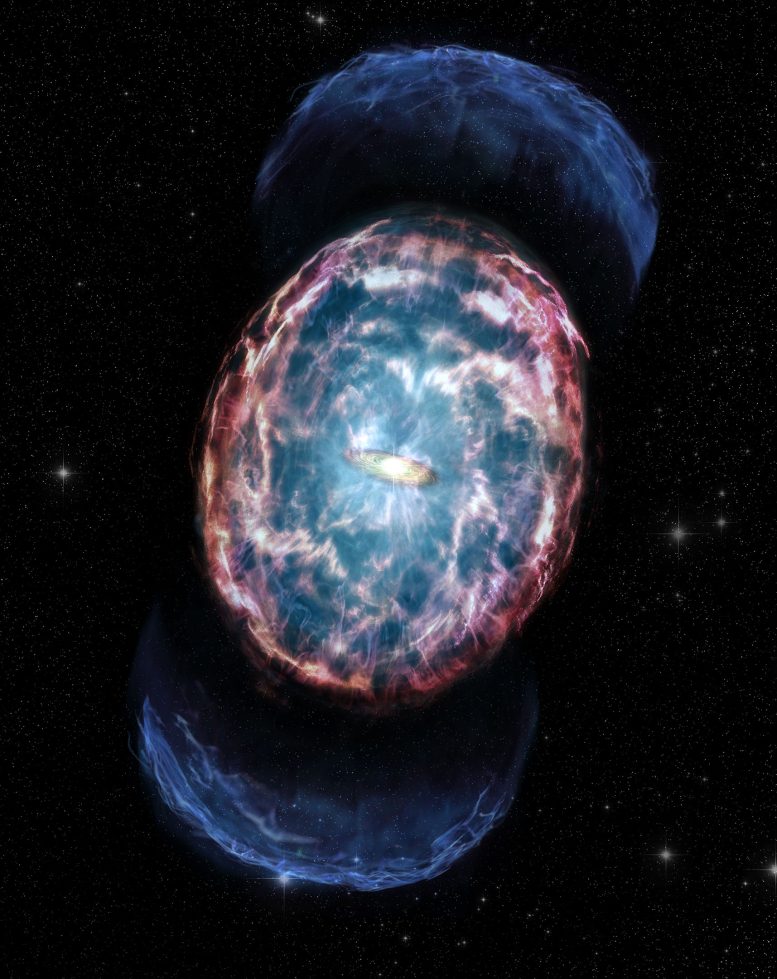
يوضح تصور الفنان تداعيات “كيلونوفا” ، وهو حدث قوي يحدث عندما يندمج نجمان نيوترونيان. الائتمان: X-ray: NASA / CXC / Northwestern Univ./A. هاجيلا وآخرون ؛ رسم توضيحي: NASA / CXC / M. Weiss
رافق “انفجار صوتي” غريب حدث غير مسبوق.
- شوهدت الأشعة السينية الغامضة بعد 3.5 سنوات من اندماج نجمين نيوترونيين
- يعتقد علماء الفيزياء الفلكية أن شفق كيلونوفا أو مواد تسقط في أ[{” attribute=””>black hole might have caused the X-ray emission
- Either scenario would be the first for the field
- The kilonova afterglow was likely produced by a shock similar to a sonic boom, generated by expanding debris from the merger
For the first time, Northwestern University-led astronomers may have detected an afterglow from a kilonova.
A kilonova occurs when two neutron stars — some of the densest objects in the universe — merge to create a blast 1,000 times brighter than a classical nova. In this case, a narrow, off-axis jet of high-energy particles accompanied the merger event, dubbed GW170817. Three-and-a-half years after the merger, the jet faded away, revealing a new source of mysterious X-rays.
As the leading explanation for the new X-ray source, astrophysicists believe expanding debris from the merger generated a shock — similar to the sonic boom from a supersonic plane. This shock then heated surrounding materials, which generated X-ray emissions, known as a kilonova afterglow. An alternative explanation is materials falling toward a black hole — formed as a result of the neutron star merger — caused the X-rays.
https://www.youtube.com/watch؟v=-QcAqtrRHyI
سيكون أي من السيناريوهين الأول من نوعه في هذا المجال. نُشرت الدراسة في 28 فبراير 2022 في رسائل مجلة الفيزياء الفلكية.
قالت ابراجيتا هاجيلا من نورث وسترن ، التي قادت الدراسة الجديدة: “لقد دخلنا منطقة مجهولة هنا لدراسة آثار اندماج نجم نيوتروني”. “نحن نبحث عن شيء جديد وغير عادي للمرة الأولى. يمنحنا هذا فرصة لدراسة وفهم العمليات الفيزيائية الجديدة ، والتي لم تتم ملاحظتها من قبل “.
هاجيلا طالبة دراسات عليا في مركز نورث وسترن للاستكشاف والبحث متعدد التخصصات في الفيزياء الفلكية (CIERA) وفي قسم الفيزياء والفلك في كلية واينبرغ للفنون والعلوم.
في 17 أغسطس 2017 ، دخل GW170817 التاريخ باعتباره أول اندماج نجمي نيوتروني تم اكتشافه بواسطة كليهما[{” attribute=””>gravitational waves and electromagnetic radiation (or light). Since then, astronomers have been using telescopes around the world and in space to study the event across the electromagnetic spectrum.
We are looking at something new and extraordinary for the very first time.”
— Aprajita Hajela, astrophysicist
Using NASA’s Chandra X-ray Observatory, astronomers observed X-ray emissions from a jet moving very close to the speed of light produced by the neutron star merger. Starting in early 2018, the jet’s X-ray emission steadily faded as the jet continued to slow and expand. Hajela and her team then noticed from March 2020 until the end of 2020, the decline in brightness stopped, and the X-ray emission was approximately constant in brightness.
This was a significant clue.
“The fact that the X-rays stopped fading quickly was our best evidence yet that something in addition to a jet is being detected in X-rays in this source,” said Raffaella Margutti, astrophysicist at the University of California at Berkeley and a senior author of the study. “A completely different source of X-rays appears to be needed to explain what we’re seeing.”
The researchers believe a kilonova afterglow or black hole are likely behind the X-rays. Neither scenario has ever before been observed.
“This would either be the first time we’ve seen a kilonova afterglow or the first time we’ve seen material falling onto a black hole after a neutron star merger,” said study co-author Joe Bright, also from the University of California at Berkeley. “Either outcome would be extremely exciting.”
To distinguish between the two explanations, astronomers will keep monitoring GW170817 in X-rays and radio waves. If it is a kilonova afterglow, the X-ray and radio emissions are expected to get brighter over the next few months or years. If the explanation involves matter falling onto a newly formed black hole, then the X-ray output should stay steady or decline rapidly, and no radio emission will be detected over time.
“Further study of GW170817 could have far-reaching implications,” said study co-author Kate Alexander, a CIERA postdoctoral fellow at Northwestern. “The detection of a kilonova afterglow would imply that the merger did not immediately produce a black hole. Alternatively, this object may offer astronomers a chance to study how matter falls onto a black hole a few years after its birth.”
The study, “Evidence for X-ray emission in excess to the jet afterglow decay 3.5 years after the binary neutron star merger GW170817: A new emission component,” was supported by NASA, the National Science Foundation, the U.S. Department of Energy and the Royal Astronomical Society.

“هواة الإنترنت المتواضعين بشكل يثير الغضب. مثيري الشغب فخور. عاشق الويب. رجل أعمال. محامي الموسيقى الحائز على جوائز.”




